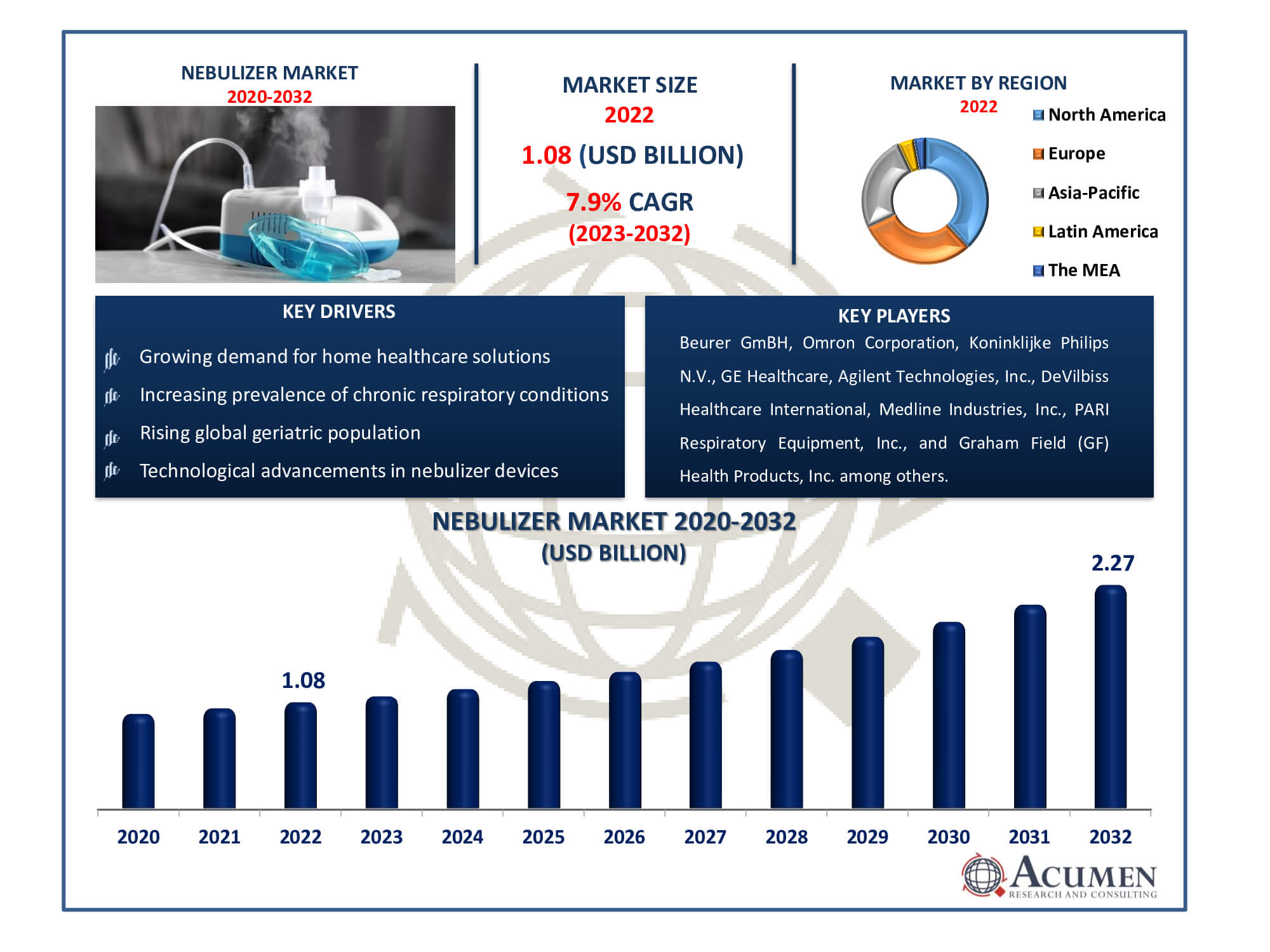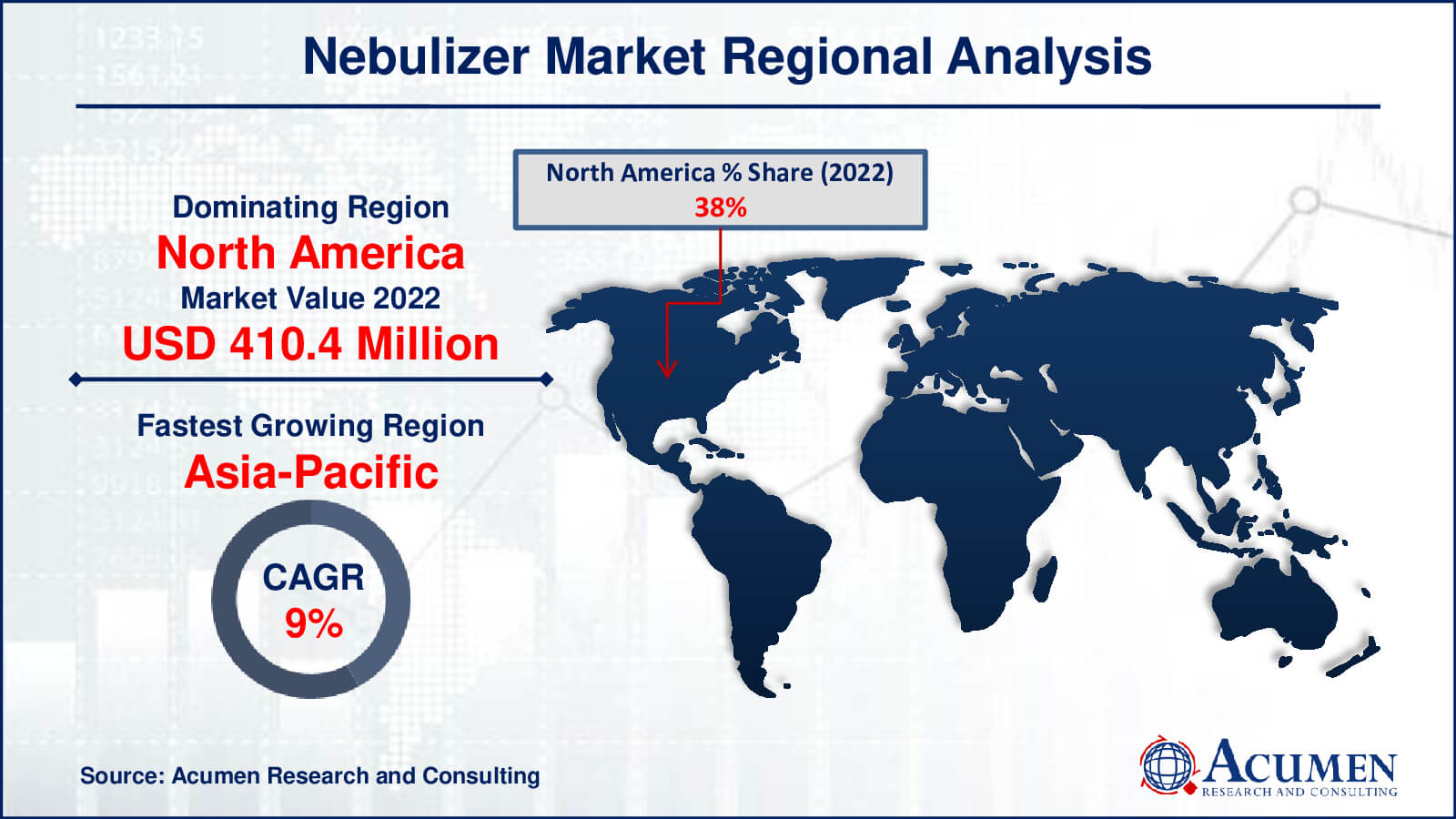November 2020
Nebulizer Market Size accounted for USD 1.08 Billion in 2022 and is estimated to achieve a market size of USD 2.27 Billion by 2032 growing at a CAGR of 7.9% from 2023 to 2032.
The Nebulizer Market Size accounted for USD 1.08 Billion in 2022 and is estimated to achieve a market size of USD 2.27 Billion by 2032 growing at a CAGR of 7.9% from 2023 to 2032.
Nebulizer Market Highlights

Nebulizer is a medical device that converts medicine into a nebula and delivers it directly into the pulmonary system. Nebulization techniques are commonly used to treat breathing conditions such as asthma, cystic fibrosis, and COPD. Various nebulization devices are available, with rechargeable and electrically powered options being the most commonly used. The global nebulizer market is projected to experience moderate growth during the nebulizer industry forecast period. This growth is driven by the prevalence of breathing conditions, especially among an aging population. The market is also boosted by the use of mobile nebulizers. However, the main constraint affecting market growth is the dispersal and waste of medication during delivery into the respiratory tract due to nebulization being a spraying technology. Additionally, the availability of nebulizer substitutes hampers further market expansion. Promising growth opportunities for this market are emerging in economies such as Asia/Pacific.
Global Nebulizer Market Dynamics
Market Drivers
Market Restraints
Market Opportunities
Nebulizer Market Report Coverage
| Market | Nebulizer Market |
| Nebulizer Market Size 2022 | USD 1.08 Billion |
| Nebulizer Market Forecast 2032 | USD 2.27 Billion |
| Nebulizer Market CAGR During 2023 - 2032 | 7.9% |
| Nebulizer Market Analysis Period | 2020 - 2032 |
| Nebulizer Market Base Year |
2022 |
| Nebulizer Market Forecast Data | 2023 - 2032 |
| Segments Covered | By Type, By Portability, By Application, By End-Use, And By Geography |
| Regional Scope | North America, Europe, Asia Pacific, Latin America, and Middle East & Africa |
| Key Companies Profiled | Beurer GmBH, Omron Corporation, Koninklijke Philips N.V., GE Healthcare, Agilent Technologies, Inc., DeVilbiss Healthcare International, Medline Industries, Inc., PARI Respiratory Equipment, Inc., Graham Field (GF) Health Products, Inc., Briggs Medical Service Company, Philips Respironics, Inc., and Besco Medical. |
| Report Coverage |
Market Trends, Drivers, Restraints, Competitive Analysis, Player Profiling, Covid-19 Analysis, Regulation Analysis |
Nebulizer Market Insights
Several key factors are driving the growth of the nebulizer market, including the high prevalence of chronic respiratory conditions, increased demand for home healthcare, and a rising global geriatric population. Technological advancements are expected to further propel this growth. A significant driver of market expansion is the prevalence of chronic diseases. For instance, the Global Burden of Disease Study estimated that in 2016, approximately 251 million people worldwide suffered from COPD. Additionally, the World Health Organization (WHO) reported around 3.17 million COPD-related deaths in 2015.
Initiatives like the Global Appeal Alliance aim to increase the rate and diagnosis of respiratory disorders, potentially boosting the market for nebulizers. Moreover, the 2015 WHO report highlighted that 16 million people die each year before the age of 70 due to non-communicable diseases. Furthermore, the increased prevalence of respiratory disorders may be influenced by factors such as obesity, unhealthy eating habits, lack of physical activity, and excessive tobacco/alcohol consumption. Over the nebulizer market forecast period, these factors could contribute to market growth.
The nebulizer market is highly competitive with other drug delivery systems, such as dry powder inhalers and inhalers, which pose a significant threat to the medical device. The benefits of these substitutes include mobility, speedier administration, and accurate dosage delivery. Their ease of use and effectiveness outweigh the nebulizer's technique, which restricts its market growth. The nebulizer market faces a challenge from the preference for alternatives because of its efficacy and convenience of use, which hinders its wider acceptance despite its intrinsic benefits.
Nebulizer Market Segmentation
The worldwide market for nebulizer is split based on type, portability, application, end-use, and geography.
Nebulizer Types
According to nebulizer industry analysis, jet nebulizers are the most popular variety of the three types of nebulizers available on the market ultrasonic, mesh, and jet. They work by forcing air into little particles so that pills can be inhaled. Because of their cost, robustness, and capacity to handle a variety of drugs, jet nebulizers are preferred. Their ease of use and efficiency in administering medication to the respiratory system make them a well-liked option, particularly in medical environments. Because of its affordability and dependability, the jet nebulizer continues to dominate the nebulizer business, even in the face of competition from more modern technologies like mesh and ultrasonic nebulizers.
Nebulizer Portability
The tabletop segment is the most popular category in the nebulizer market. These nebulizers have a high efficiency and reliable performance, making them ideal for stationary use. Because of its strength and capacity to handle a variety of drugs, tabletop nebulizers are recommended for both home and professional use. Tabletop nebulizers are preferred in medical settings despite the rise of portable models because of their durability, dependability, and efficiency in dispensing medication. Their stationary design doesn't take away from their allure; their reliable performance and versatility in handling different drugs keep them at the top of the nebulizer industry.
Nebulizer Applications
As per the nebulizer industry analysis, COPD (Chronic Obstructive Pulmonary Disease) is the leading application for nebulizers. Millions of people throughout the world suffer from this illness, which is why there is a need for efficient respiratory therapies. Because they administer medicine directly to the lungs, nebulizers are essential for controlling the symptoms of COPD and facilitating better breathing. Due to the chronic nature of COPD and its high incidence, nebulizers are an essential instrument for treating the condition using reliable and effective methods. Nebulizers are also used to treat other disorders like cystic fibrosis and asthma, however the market's demand for nebulizer usage is mostly driven by COPD due to its prevalence and chronic nature.
Nebulizer End-Uses
Among end users, hospitals and clinics hold the most market share for nebulizers. Nebulizers are a major component of these settings effective and precise respiratory drug delivery systems. Nebulizers are essential for treating a wide range of respiratory disorders in clinics and hospitals, serving a diverse patient population with varying needs. Their importance in healthcare institutions is solidified by their ability to dispense a variety of drugs and their application in acute and chronic care settings. Nebulizers are useful in emergency rooms and home health care, but their dominant market share in hospitals and clinics is maintained by the high demand and importance of respiratory care in these settings.
Nebulizer Market Regional Outlook
North America
Europe
Asia-Pacific
Latin America
The Middle East & Africa

Nebulizer Market Regional Analysis
North America accounted for the biggest market share in 2022 due to the increase in the prevalence of chronic respiratory disorders and is expected to experience significant growth throughout the nebulizer market forecast period. COPD stands out as a leading cause of death in the USA, as per the Centers for Disease Control and Prevention (CDC). The expanding geriatric population in North America contributes to a rise in respiratory disorders, fostering growth in the region. Statistics Canada reported a significant percentage of individuals aged 65 and over, supporting the expansion of homecare services.
The Asia-Pacific Region is poised to demonstrate the fastest Compound Annual Growth Rate (CAGR) due to its increasing geriatric population and incidences of respiratory diseases. COPD remains a significant cause of death in Japan, with cases notably increasing in recent years according to the Institute for Health Metrics and Evaluation. Additionally, countries like India and China bear a considerable burden of pulmonary diseases. The World Health Organization (WHO) notes a substantial portion of COPD-related deaths in middle and low-income countries, notably in China and India. This region is set for substantial market growth, driven by the high prevalence of respiratory diseases, increased healthcare spending, and rising patient awareness.
Nebulizer Market Players
Some of the top nebulizer companies offered in our report includes Beurer GmBH, Omron Corporation, Koninklijke Philips N.V., GE Healthcare, Agilent Technologies, Inc., DeVilbiss Healthcare International, Medline Industries, Inc., PARI Respiratory Equipment, Inc., Graham Field (GF) Health Products, Inc., Briggs Medical Service Company, Philips Respironics, Inc., and Besco Medical.
Looking for discounts, bulk pricing, or custom solutions? Contact us today at sales@acumenresearchandconsulting.com
November 2020
September 2023
August 2023
December 2020